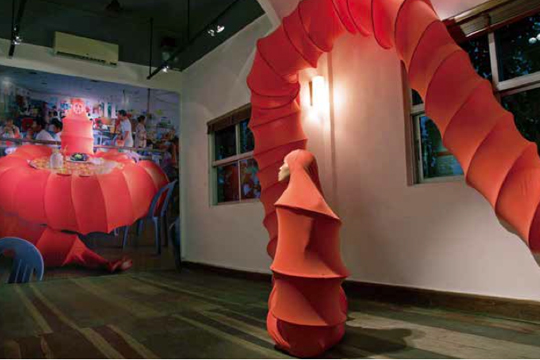ANIDA YOEU ALI: BUDDHIST BUG PROJECT
| June 5, 2013 | Post In LEAP 20

The exiled knows that in a secular and contingent world, homes are always provisional. Borders and barriers which enclose us within the safety of familiar territory can also become prisons and are often defended beyond reason or necessity.
— Edward Said
Anida Yoeu Ali’s “Buddhist Bug Project” offers a particularly unique perspective on dis- placement: through hyperreal visual experience, the artist draws clear distinctions between the intellectual subject and object, the self and the other, the extraordinary and the everyday, the outsider and the local, all while simultaneously constructing a bridge to connect these binary concepts.
In the imagined narrative of this project, Ali herself actually embodies a kind of overlapped, inter-subjective position. The Bug is over 30 meters in length, with bright orange skin and a sleek head. At one end is a human face tightly encircled in cloth, and at the other a pair of foreign looking feet. Its gargantuan, eye-catching size aside, the worm’s female face and human feet produce involuntary projections of the self in the viewer, which in turn strengthens the Bug’s actual existence as an assemblage of disparate elements, the connection between human features and insect body puzzling the spectator. This strange construction, collapsible and transportable, was created in direct response to certain painful memories of Ali’s escape to the USA as a child. Its bright orange color is the same one worn by Buddhist monks, and represents Cambodia’s profound Buddhist culture, while the cloth that tightly encircles the Bug’s female face represents both the hijab worn by some Muslim women, and the ethnic minority of Cambodian Muslims to which Ali and her family belong.
Ali’s identity, narrated in the “Buddhist Bug Project,” is indeed complex: born in Cambodia, she grew up in the USA and was given a traditional Muslim upbringing, until the age of 25, when she returned to her birthplace and experienced Cambodia directly for the first time. She was then profoundly affected by the rich culture and customs of her native land, its smells, colors, rhythms, its dance. Mahayana Buddhist culture permeates all of Cambodia. Thus Ali drew both on her complex emotional relationship towards Cambodia and her own identity, using the “Buddhist Bug Project” and its position between displacement and belonging to conduct a dialectical study.
At the time of writing, the “Buddhist Bug Project” is actually in its second incarnation; the project was first performed and displayed in the country she grew up in. Ali has stated emphatically that compared to native dwellers, immigrant families experience a far more severe form of generational displacement. The first “Buddhist Bug Project” actually came out of a comprehensive review of her practice, which encompasses video, performance, sculptural installation, and textiles. Though more significantly, Ali’s formal leaps across a variety of performative mediums have led to the development of a complex creative vocabulary.
This exhibition features videos of two publicly-staged “Buddhist Bug” performances, as well as many photographs documenting the project; the Bug itself made an appearance at the opening for a special on-site performance. In comparison to the severe Buddhist ponderings of its first American phase, in its second the project appears to adopt a more humorous, intentionally awkward, and confused stance; the Bug’s parade through city streets drew attention to the rapidly urbanizing Phnom Penh and its rich and diverse ethnic communities. However, the many startled expressions of witnesses to this spectacle, as seen in the documentary videos, seem to echo the familial displacement which Ali herself experienced. They perhaps even confirm the extent to which Ali is limited by her own unique identity. (Translated by Dominik Salter Dvorak)


